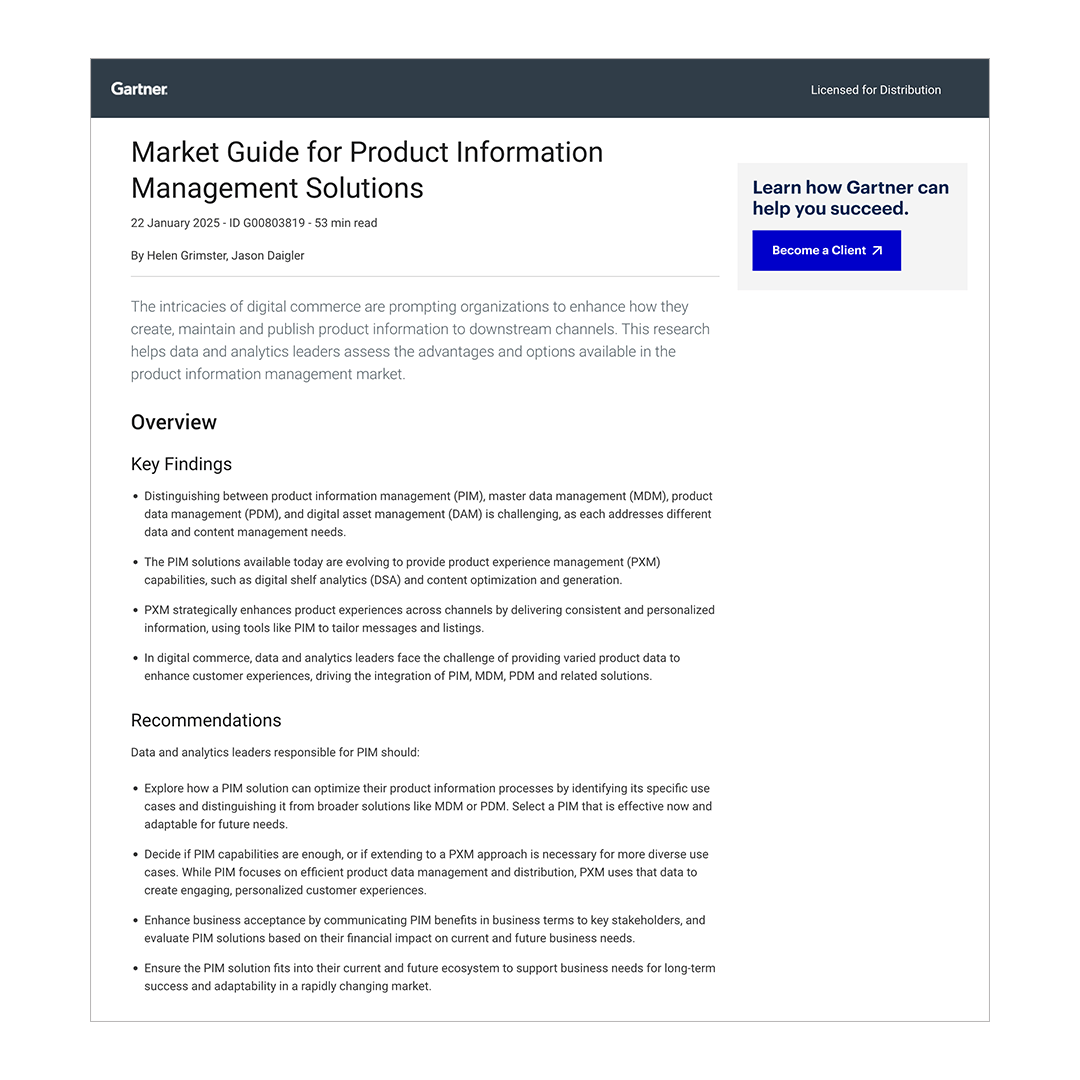- Home
- Product Experience Management
Perfected.
Surpass customer expectations with Product Experience Management software
Connect with your customers at every step. Deliver rich, accurate, and omnichannel-ready product experiences — anytime, anywhere with Contentserv’s Product Experience Management platform.
Context-first. Insight-powered. Customer-focused.
Enrich
Model, enrich, and localize content, attributes, and digital assets from any source.
Contextualize
Customize product pages using channel insights to optimize distribution and maximize satisfaction.
Target
Ensure seamless workflow, making it easy for customers to connect with your brand across all channels.
Optimize
Gain a customer-centric view, make data-driven decisions, and optimize with Channel Insights.
believe their experience is as important as the product or service.
will stop buying from brands with poor personalization efforts.
Start here.
What is Product Experience Management (PXM) software?
Product Experience Management transforms traditional PIM systems into an intelligent product experience engine that provides personalized and contextualized product content based on your customers’ channel, locale, and preferences. It unifies data from sources like MDM, ERP, and PLM, while integrating PIM and DAM to streamline syndication, content management, pricing, and personalization. By combining PIM and DAM, our PXM software ensures the delivery of personalized, context-aware product experiences.
Create impactful connections
Foster meaningful interactions that engage customers, strengthen loyalty, and build lasting relationships across every touchpoint.
Influence purchasing decisions
Shape consumer choices with tailored experiences and personalized product content
Amplify brand perception
Elevate your brand’s visibility by delivering consistent, compelling experiences that align with your values.
Improve product content ROI
Maximize returns by optimizing your content strategy, ensuring it’s personalized, relevant, and consistent.
Why do you need a PXM platform?
A PXM platform is your key to winning customers with personalized, seamless experiences that build loyalty, boost sales, and help you stand out in a competitive digital landscape.
From data to experience: Contentserv's precise product delivery
Composable data management
We streamline content management across all channels, optimizing data creation, delivery, and feedback collection on internal and external platforms.
Powerful 360° view of product content
Contentserv creates immersive product stories, with rich descriptions, engaging images, videos, and more to connect with customers across channels and regions.
Contextual product experiences guiding customer choices
We create personalized, contextual, and engaging journeys that inspire confidence and guide customers to informed decisions, driving sales and retention.
Design perfect product experiences with ease
Personalized storytelling:
Engage customers with personalized content that resonates with their preferences and needs.
Holistic product experience:
Enrich content experiences with engaging catalogs, multimedia elements like images, videos, and contextualized content tailored for every touchpoint.
Context-driven optimization:
Enhance product performance through context-sensitive data across markets, languages, and locales.
AI-powered delivery:
Automate the delivery of customized experiences using AI and ML for real-time, data-driven optimization.
What are the benefits of a PXM system?
Ready for every challenge, every channel
Elevate customer experience
Tailor personalized and relevant content across all customer touchpoints with the PXM platform.
Strengthen omnichannel strategy
Ensure consistent product content across digital and physical channels, delivering a consistent experience everywhere.
Boost content flexibility
Quickly adapt and scale content delivery to meet evolving customer demands with PXM’s composable architecture.
Increase operational efficiency
Streamline end-to-end product data management, from onboarding to feedback management, improve team collaboration, and reduce time spent on manual tasks.
The right solution for your business or industry
Thrive on tailored connections: Create a positive buying experience with PXM's AI-powered framework, driven by PIM for efficient product delivery.
How it works
Data enrichment
Enrich
Enhance product descriptions using detailed, high-quality data
Enhance
Add images, videos, and documents to every product listing
Localize
Adapt and translate data to align with each market and region
Personalization & contextualization
Contextualize
Tailor product pages to meet customer needs and purchase intent
Distribute
Publish and deliver rich content across all customer touchpoints
Promote
Create and manage impactful campaigns tailored to personas, situations, channels
Feedback integration
Collect
Gather customer feedback to refine and enhance product content
Analyze
Examine customer needs to predict and meet their future expectations
Close the loop
Act on data quickly to consistently improve overall product experiences
Essential components of PXM
Our PXM software unifies data from sources like MDM, ERP, and PLM, integrating Product Information Management and Digital Asset Management to streamline the delivery of hyper-personalized product experiences.
Elevate the experience: Navigating compliance, regulations, and sustainability for a future-ready PXM
In today’s regulatory landscape, Product Experience Management (PXM) is essential not only for customer engagement but also for meeting evolving compliance standards. New requirements, such as the EU Green Deal's Digital Product Passport (DPP), the EU Accessibility Act, and the U.S. Food Safety Modernization Act (FSMA) are raising the bar for transparency, accessibility, and traceability.
And that’s only the beginning. More regulations, including the Ecodesign for Sustainable Products Regulation (ESPR), the Supply Chain Due Diligence Act (e.g., Germany’s Lieferkettengesetz), and the Circular Economy Action Plan (CEAP) demand sustainable and ethically sourced product lifecycles. Extended Producer Responsibility (EPR) programs like GDPR and the California Consumer Privacy Act (CCPA) and GDPR set stringent standards that may soon extend to product data.
Regulations like REACH and RoHS add requirements around hazardous substances, underscoring the need for transparency on materials, chemicals, and sourcing.
Our PXM solution is built to support compliance with these standards, turning regulatory demands into a strategic advantage. With tools to manage sustainability initiatives like the EU DPP and in-store transparency through 2D barcode your PXM strategy becomes future-ready, meeting customer demand for ethical, sustainable products while positioning compliance as a competitive differentiator.
Turning data into trust: The power of product transparency
In this webinar with our customer, Belgian toolmaker Varo – conducted and originally published by our partner ‘Parsionate – Part of Accenture’ – you can learn how a strong database and our comprehensive PIM system support transparency initiatives like the DPP, driving growth and differentiation in the market. Discover how Varo is confidently leveraging 2D barcodes to enhance customer experience and trust.
Contentserv is recognized in the Gartner® Market Guide for PIM
Automate enrichment, leverage real-time analytics, and use closed-loop feedback to ensure your product experiences stay optimized and market-ready.

Frequently asked questions about PXM
What does PXM stand for?
PXM is Product Experience Management. It refers to the strategy of delivering tailored content by channel, locale, and need, fostering emotional connections with customers.
What is the PXM solution?
The PXM platform combines PIM with tools for analyzing, personalizing, and optimizing content. Using AI and ML, it automates processes and delivers tailored experiences via content syndication, feed management, and channel insights.
What can you do with PXM?
PXM enables 360-degree content experiences across sales channels, delivering context-aware, location-relevant content in multiple languages. It helps businesses expand to new channels like apps, websites, marketplaces, and ecommerce platforms.
How does PXM help?
PXM leverages AI and ML to enhance customer data from PIM, analyzing, personalizing, and optimizing product information for better experiences across all channels.
What is the difference between PXM and PIM?
PIM focuses on data, while PXM focuses on customer experience. PIM manages and centralizes product data for consistency across channels, while PXM personalizes and delivers context-sensitive experiences, incorporating customer preferences for tailored, emotionally engaging interactions.








